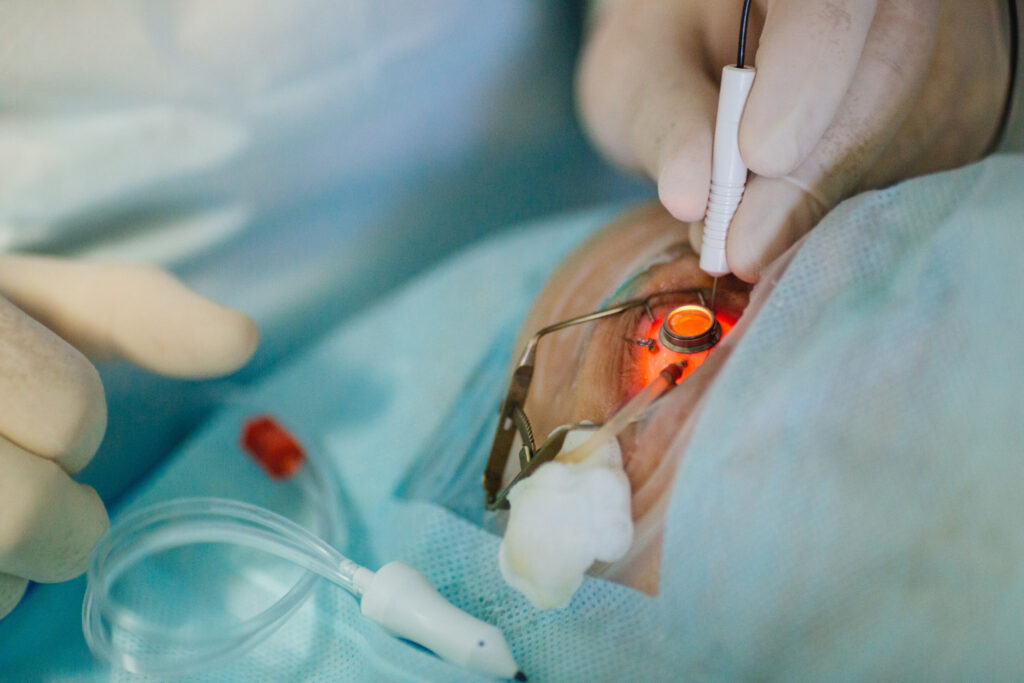Cataracts are a common visual impairment that many people experience as they age. While they are often treatable, understanding when to seek intervention can be pivotal for maintaining quality of life. This article will guide you through the basics of cataracts, their symptoms, the surgery process, and when it might be advisable to consider treatment.
Understanding Cataracts: A Brief Overview
Cataracts are a clouding of the lens in the eye, leading to a decrease in vision. They develop slowly and can affect one or both eyes. Understanding the nature of cataract eye surgery is essential for recognizing the signs and seeking timely medical advice.
What are Cataracts?
The human lens, located behind the iris and pupil, helps focus light onto the retina. Over time, proteins in the lens can clump together and form cataracts, which obstruct the passage of light. This process usually occurs gradually, and the vision may become blurry, dim, or distorted.
In the early stages, cataracts may not significantly affect your daily life. However, as they progress, they can interfere with activities such as reading, driving, and recognizing faces. Hence, it’s crucial to be informed about cataracts and their potential impact on vision. Symptoms can vary widely; some individuals may experience halos around lights, increased sensitivity to glare, or even double vision in some cases. These changes can be subtle at first, leading many to underestimate their severity until they become more pronounced.

The Causes and Risk Factors of Cataracts
Cataracts occur due to various factors, both intrinsic and extrinsic. Age is the most significant risk factor; as individuals grow older, the chances of developing cataracts increase. Additionally, other contributing factors include:
Genetics: A family history of cataracts may raise your risk.
Diabetes: This chronic condition is known to accelerate cataract formation.
Smoking: Tobacco use is linked to higher incidence rates of cataracts.
Prolonged sun exposure: Ultraviolet (UV) light from the sun is another risk factor.
Certain medications: Some medications, especially steroids, can contribute to cataract development.
Identifying these risk factors can help in taking preventive actions and preparing for necessary evaluations. For instance, regular eye exams can be crucial for early detection, especially for individuals with diabetes or a family history of eye conditions. Moreover, lifestyle choices such as wearing UV-blocking sunglasses, maintaining a healthy diet rich in antioxidants, and quitting smoking can significantly reduce the risk of cataract formation. Awareness of these factors not only empowers individuals to take charge of their eye health but also fosters a proactive approach towards regular check-ups and discussions with healthcare professionals about vision changes.
Recognizing the Symptoms of Cataracts
Awareness of the symptoms associated with cataracts is vital for early diagnosis and treatment. Many people may overlook the initial signs, mistaking them for normal aging processes. Understanding how to recognize these symptoms can lead to prompt medical consultation. Early detection can significantly improve the quality of life, allowing individuals to maintain their independence and continue engaging in activities they love. Learn about why engaging in activities is important at https://instructionalmoves.gse.harvard.edu/engaging-students
Early Signs of Cataracts
In the initial stages, cataracts may present subtle signs, including:
Blurry or cloudy vision
Difficulty seeing at night
Increased sensitivity to light and glare
Halos around lights
As these symptoms become more pronounced, they can severely impair daily functions and activities, making it important to address them early on. For instance, those who enjoy reading or driving may find these tasks increasingly challenging, leading to frustration and a decrease in overall quality of life. Additionally, individuals may begin to rely more on others for assistance, which can impact their sense of autonomy and self-esteem.
How Cataracts Affect Your Vision
The impact of cataracts on vision varies from person to person. As cataracts mature, they can lead to:
Significant blurriness that affects reading and digital screens
Loss of color vibrancy
Faded or dim vision, making environments feel darker
If you notice changes in your vision that align with these symptoms, scheduling a visit with an eye care professional is crucial. Moreover, the progression of cataracts can also lead to challenges in recognizing faces and navigating familiar environments, which can be particularly distressing. It’s essential to stay informed about the condition and consider preventive measures, such as regular eye exams, to monitor any changes in vision over time.
The Process of Cataract Eye Surgery
If cataracts are significantly affecting your quality of life, surgery may become necessary. Understanding the surgical process can alleviate fears and provide clarity on what to expect.
Preparing for Cataract Surgery
Before surgery, your eye doctor will conduct a comprehensive examination, including a vision assessment and an evaluation of the cataract’s severity. You may also undergo imaging tests to measure the size and shape of your eye and lens. This data will help the doctor determine the best course of action.
Preparing for surgery may involve discontinuing certain medications that can affect healing. Your doctor will provide specific guidelines on how to prepare, including which food and drink restrictions to observe on the day of surgery. It’s also advisable to arrange for a pre-surgery consultation where you can ask any lingering questions and discuss your concerns. This meeting can help ensure that you feel fully informed and comfortable with the upcoming procedure. To read more about Preparing for cataract surgery click here.
What Happens During the Surgery?
Cataract surgery is typically performed as an outpatient procedure, meaning you won’t need to stay overnight at the hospital. The surgery usually takes less than an hour and is performed under local anesthesia.
The most common technique involves:
Removing the cloudy lens from your eye.
Replacing it with an artificial intraocular lens (IOL) to restore clarity.
Many patients report immediate improvements in their vision after the procedure, although it may take some time to stabilize fully. The type of IOL chosen can also affect your post-surgery vision. Options include monofocal lenses, which provide clear vision at one distance, and multifocal lenses, which can help with both near and far vision. Discussing these options with your surgeon can help tailor the procedure to your lifestyle needs.
Post-Surgery: What to Expect
After cataract surgery, you’ll need to arrange for someone to drive you home. Initially, you may experience blurry vision, which is common. Your doctor will provide post-operative care instructions, which may include:
Using prescribed medicated eye drops
Avoiding strenuous activities for a few weeks
Scheduling follow-up appointments for checks on healing
Positive outcomes from cataract surgery are reported by the vast majority of patients, leading to improved quality of life. However, attending follow-up appointments is critical for appropriate healing. During these visits, your doctor will monitor your recovery, check for any signs of complications, and adjust your treatment plan as necessary. It’s also important to protect your eyes from bright lights and dust, as they can be sensitive during the initial recovery phase. Many patients find that wearing sunglasses outdoors helps alleviate discomfort and promotes healing.
Evaluating the Pros and Cons of Cataract Surgery
Like any medical procedure, cataract surgery has its benefits and risks. Weighing these factors can help in making an informed decision.
The Benefits of Cataract Surgery
The most notable benefit of cataract surgery is improved vision. A successful procedure can lead to:
Restoration of clarity in vision
Enhanced ability to engage in daily activities
Improved safety in situations like driving at night
Overall, the level of satisfaction reported post-surgery is high, with many patients expressing relief and joy at regaining their sight. In addition to these immediate benefits, many patients experience a significant boost in their overall quality of life. Activities that were once challenging, such as reading, gardening, or enjoying nature, become more accessible and enjoyable. This newfound clarity often encourages individuals to participate more actively in social events and hobbies, fostering a sense of connection and fulfillment.
Moreover, advancements in surgical techniques and technology, such as the use of laser-assisted surgery and premium intraocular lenses, have made the procedure even more effective and customizable. These innovations allow for tailored solutions that can address specific vision issues, such as astigmatism or presbyopia, further enhancing the visual outcomes for patients.
Potential Risks and Complications
While cataract surgery is generally safe, it’s essential to be aware of the potential risks, including:
Infection at the surgical site
Swelling of the retina
Visual disturbances such as halos or double vision
Discussing these risks with your eye surgeon can help in assessing whether the benefits outweigh the potential complications. It’s also important to consider that while serious complications are rare, they can occur and may require additional treatment or follow-up procedures. Patients should be encouraged to maintain realistic expectations and understand that recovery can vary from person to person, with some experiencing immediate improvements while others may take longer to adjust to their new vision.
Furthermore, pre-existing health conditions, such as diabetes or glaucoma, can also influence the surgery’s outcome and the recovery process. Therefore, a thorough pre-operative assessment and open dialogue with healthcare providers are crucial to ensuring a successful experience. Understanding these factors can empower patients to make the best choices for their eye health and overall well-being.

When to Consider Cataract Eye Surgery
Determining the right time for cataract surgery is a personal decision that depends on a combination of factors, including the severity of your cataracts and how they affect your life.
Assessing Your Eye Health
If you experience vision changes that obstruct daily tasks, it may be time to consult an eye care professional. Regular eye exams can identify changes that might necessitate treatment.
Your eye doctor may recommend surgery if your vision impairment is leading to difficulties in work, social activities, or personal safety. Trusting your instincts and seeking expert advice can guide this important decision.
Discussing Your Options with Your Eye Doctor
A crucial aspect of the decision-making process is engaging with your healthcare provider. Discussing your concerns and asking questions will enable you to make an informed choice regarding cataract surgery.
Understanding all available options, including lifestyle adjustments and nonsurgical treatments, is vital. Collaborating with your doctor will help you evaluate the best approach based on your unique circumstances.
In conclusion, cataracts are a pervasive issue that affects many individuals, especially as they age. Awareness of symptoms, understanding the surgical process, and weighing the pros and cons are essential factors in deciding whether cataract surgery is right for you. If you’re experiencing vision difficulties, consult your eye care professional to ensure that your sight remains bright.
Related : Cataract Surgery in Sydney: What to Expect and How It Can Improve Your Vision
